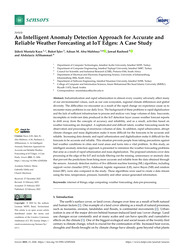An Intelligent Anomaly Detection Approach for Accurate and Reliable Weather Forecasting at IoT Edges: A Case Study
-
Yazar
Buket İşler
-
Tür
Makale
- Yayın Yılı 2023
- Veritabanları Wos,Scopus,PubMed
- DOI 10.3390/s23052426
-
Yayıncı
Sensors
- Dergi Sensors 23, ( 5 ), pp.1 - 17
- Tek Biçim Adres https://hdl.handle.net/20.500.14081/1841
-
Konu Başlıkları
Internet of things
Edge computing
Weather forecasting
Data pre-processing
Industrialization and rapid urbanization in almost every country adversely affect many of our environmental values, such as our core ecosystem, regional climate differences and global diversity. The difficulties we encounter as a result of the rapid change we experience cause us to encounter many problems in our daily lives. The background of these problems is rapid digitalization and the lack of sufficient infrastructure to process and analyze very large volumes of data. Inaccurate, incomplete or irrelevant data produced in the IoT detection layer causes weather forecast reports to drift away from the concepts of accuracy and reliability, and as a result, activities based on weather forecasting are disrupted. A sophisticated and difficult talent, weather forecasting needs the observation and processing of enormous volumes of data. In addition, rapid urbanization, abrupt climate changes and mass digitization make it more difficult for the forecasts to be accurate and reliable. Increasing data density and rapid urbanization and digitalization make it difficult for the forecasts to be accurate and reliable. This situation prevents people from taking precautions against bad weather conditions in cities and rural areas and turns into a vital problem. In this study, an intelligent anomaly detection approach is presented to minimize the weather forecasting problems that arise as a result of rapid urbanization and mass digitalization. The proposed solutions cover data processing at the edge of the IoT and include filtering out the missing, unnecessary or anomaly data that prevent the predictions from being more accurate and reliable from the data obtained through the sensors. Anomaly detection metrics of five different machine learning (ML) algorithms, including support vector classifier (SVC), Adaboost, logistic regression (LR), naive Bayes (NB) and random forest (RF), were also compared in the study. These algorithms were used to create a data stream using the time, temperature, pressure, humidity and other sensor-generated information.
-
Koleksiyonlar
Fakülteler
Mühendislik Fakültesi


 Tam Metin
Tam Metin

